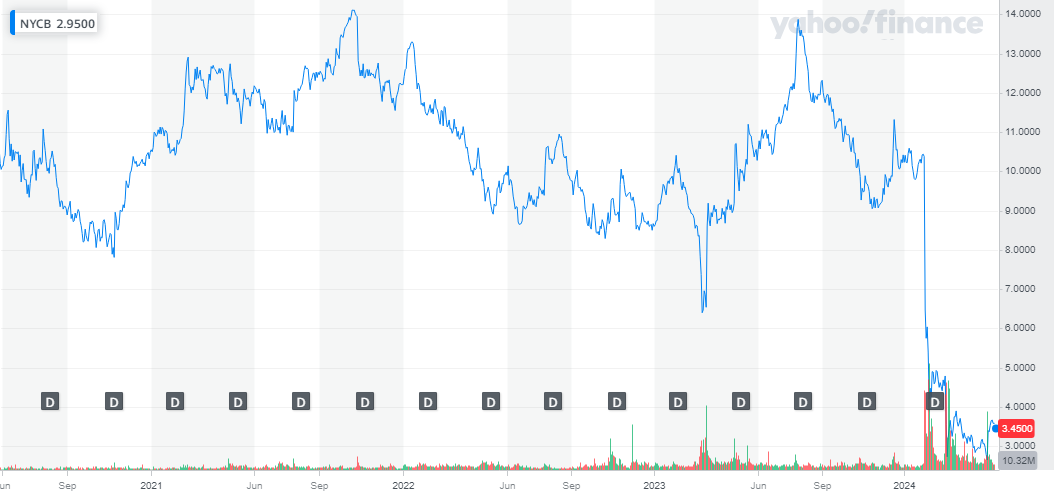Regulations Ensure No Bank Rescue Goes Unpunished
On 31 January 2024, New York Community Bancorp (NYSE: NYCB) dropped a bombshell earnings report. Instead of reporting anything close to the $0.29 profit per share investors expected, the bank reported a $0.27 per share loss.
That the situation was bad was confirmed by the bank's surpise "massive" dividend cut, which signaled the bank's management was seeking to raise capital. NYCB's quarterly dividend slashed by 70.6% from 17 to 5 cents per share. Investors responded to the sudden, negative change in their outlook for NYCB by sending its stock price plunging by 37.7%, falling from $10.38 at the close of trading on 30 January 2024 to $6.47 per share a day later.
Flashing forward to 1 May 2024, NYCB's dividend outlook got worse as its earnings for the first quarter of 2024 fell short of expectations. As part of its announced plan to recover its profitability, NYCB further slashed its dividend to 1 cent per share. The announcement plan boosted its stock price, which had dropped as low as $2.65 per share, but which through the end of trading on 10 May 2024 was hovering around $3.45 per share.
All the same, NYCB's stock chart looks brutal.
We opted to show NYCB's daily stock price over the past five years because the period before its earnings disaster became known on 31 January 2024, the bank appeared to have weathered the major economic and banking crises of the last several years fairly well. Its stock price had recovered from both the coronavirus pandemic and the March 2023 failures of Silicon Valley Bank and Signature Bank. In fact, NYCB was considered strong enough by banking regulators that the Federal Deposit Insurance Corporation facilitated its acquisition of Signature Bank' assets less than two weeks after its failure.
In doing so, the FDIC may have set up NYCB's own earnings collapse less than a year later.
While the Signature deal strengthened NYCB's balance sheet by adding low-cost deposits and brought with it a middle-market business, the transaction also "put us over $100B in total assets, placing us firmly in the Category IV large bank class of banks between $100B and $250B in assets and subjecting us to enhanced prudential standards, including risk-based and leverage capital requirements, liquidity standards, requirements for overall risk management and stress testing," said President and CEO Thomas Cangemi.
Prior to its FDIC-facilitated acquisition of Signature Bank, New York Community Bancorp fell below the $100 billion threshold. Banks below this threshold have greater flexibility in how they manage and underwrite loans compared to larger banks that have to routinely comply with costly federal banking regulations. Regulatory requirements with which NYCB had little experience in managing, which left them exposed to risks they hadn't fully appreciated would be a consequence of the acquisition and their change in status from a small to a medium-sized bank:
“As part of management’s assessment of the company’s internal controls, management identified material weaknesses in the company’s internal controls related to internal loan review, resulting from ineffective oversight, risk assessment and monitoring activities,” the bank said in the filing.
That leads to a good question. Why did federal regulators facilitate NYCB's acquisition of Signature Bank? Weren't they aware the bank's established loan review and risk assessment practices weren't capable of meeting the requirements of the new regulatory status into which they were promoting them? And if they were not, why not?
NYCB has put forward their plan to address their identified shortfalls in their loan review processes. Where is the federal regulators plan to address where they fell short in pushing through the acquisition to NYCB? What actions could they have taken to help get NYCB up to speed with their new regulatory requirements?
These questions must be asked because of what could happen the next time banking regulators have a crisis. Maybe the next time around, other banks that might consider assisting the rescue will sit out instead because of what happened with NYCB. What do you suppose the consequences of a failed bank rescue might be? The current system in which those who come to the rescue of a failed bank with the assistance of federal regulators are punished because of it doesn't qualify as any kind of smart policy.
If you think about it, the now demonstrated risk from increased regulatory exposure could lead other small banks to deliberately restrain their growth to keep their asset level below the arbitrary threshold regulators have set. What consequences to the industry and to the economy might follow from that?
Afterword
NYCB will partially address its "size" problem by getting smaller. The bank announced on 14 May 2024 that it is reducing its commercial real estate loan portfolio by selling $5 billion in mortgage warehouse loans to JPMorgan Chase (NYSE: JPM).
More By This Author:
Year-Over-Year Growth Of CO2 Emissions Stalls In April 2024
Trade Between U.S., China, And Rest Of The World Falls In Storm Of Anti-Free Trade Policies
S&P 500 Rises As Expectations Firm For Rate Cuts Later In 2024
Disclosure: Materials that are published by Political Calculations can provide visitors with free information and insights regarding the incentives created by the laws and policies described. ...
more



